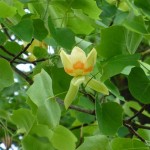Your turn:
Like you said in your book Kim, I need to plant trees for shade around my new house. I have a lot of room and want a good tree that grows pretty fast. – DA, Hope Mills
My turn:
One of the best native trees that fits your description is the Tulip Poplar (Liriodendron tulipifera L.)
It starts as an attractive shade tree with a neat pyramidal form. Plan ahead because it spreads out to ultimately grow 80 – 120 feet high with a 2-5 foot diameter trunk!
Over the years, you will definitely enjoy it’s unusual leaves, attractive flowers, bark and low maintenance.
Tulip Poplar isn’t a true poplar, it is actually a member of the magnolia family. The leaves are a medium-large shiny, dark green tulip-shape that flutter in the breeze.
You may see some munched-on leaves where butterfly larva have had lunch. No worries, there’s plenty of leaves to share!
The pretty green-yellow tulip-shaped flowers appear from April to June. During that time, watch for hummingbirds sipping nectar around your tree.
It also has a pleasant yellow fall color. The cone-shaped fruit clusters usually stay on the branches and provide food for squirrels in the late fall and winter.
The bark on younger trunks is quite smooth, light ash-gray. With age the bark becomes thick with deep interlacing furrows and rounded ridges giving it character and adding yard curb appeal.
It grows best in moderately moist, deep, well drained, loose textured soils in sunny locations. Avoid very dry or very wet situations. Consider planting Tulip Poplar on the north-northwest sides of your home for energy-saving windbreak and afternoon shading.
Since it grows quite rapidly, Tulip Poplar can be damaged by wind and ice in exposed situations, so cluster it with other trees and shrubs.
Another storm-proofing measure is periodic branch trimming. As with most trees, the strongest branches attach to the trunk at a 90-degree angle and do not crowd each other. Occasionally trim away those not fitting that description.
Tulip poplar is unusually free from insects and disease which will allow you plenty of time for a picnic under this tree!
Native plants, like this Tulip Poplar give you a bunch of benefits:
- Saves you time, energy, and money spent on yard maintenance
- Raises your property values
- Promotes neighborhood biodiversity
- Attracts a variety of wildlife to your yard
- Prevents or reduces yard erosion
- Encourages rain to stay on your property
- Reduces the need for herbicide, pesticide, and fertilizers
If you got the room, this tree is a winner!

